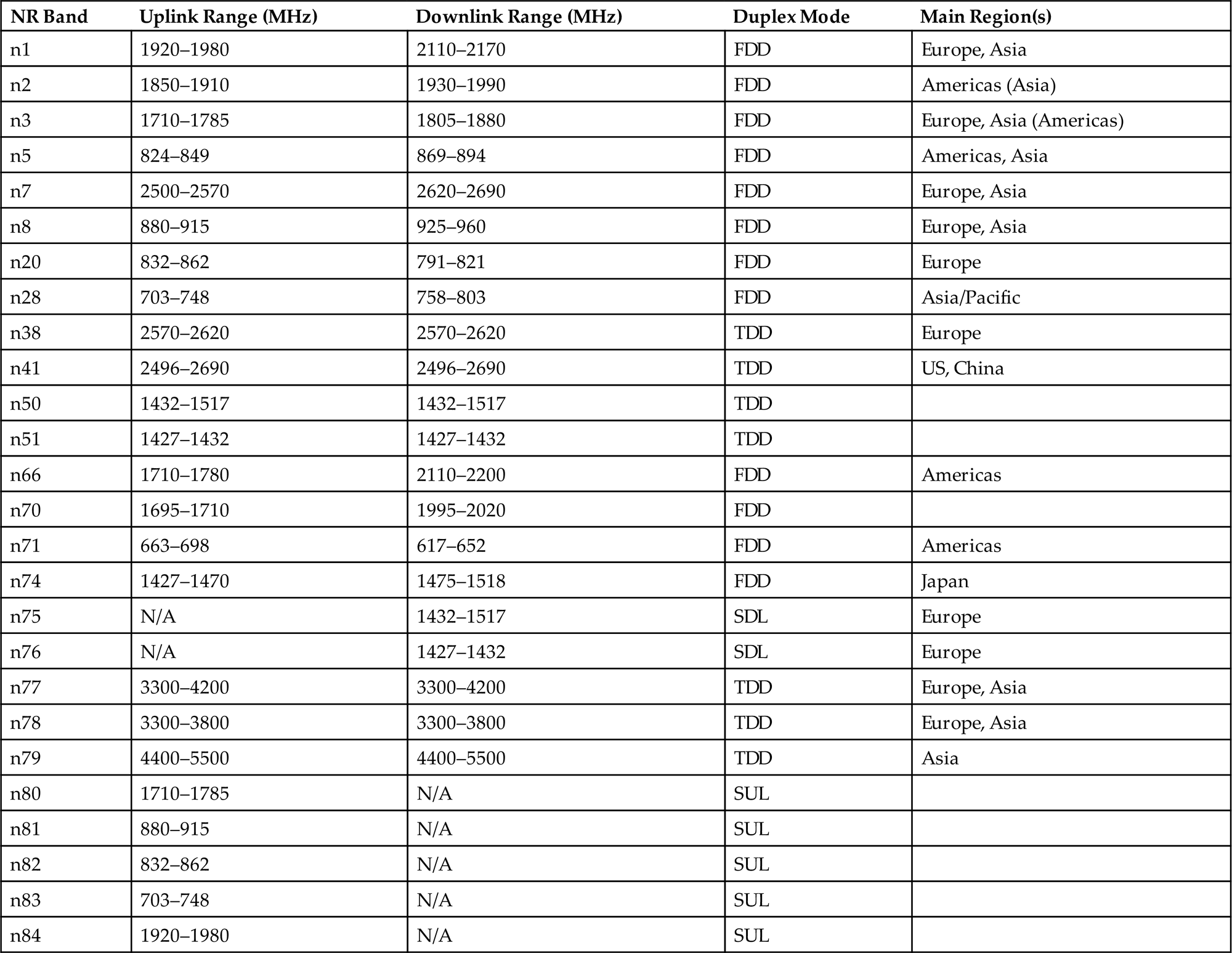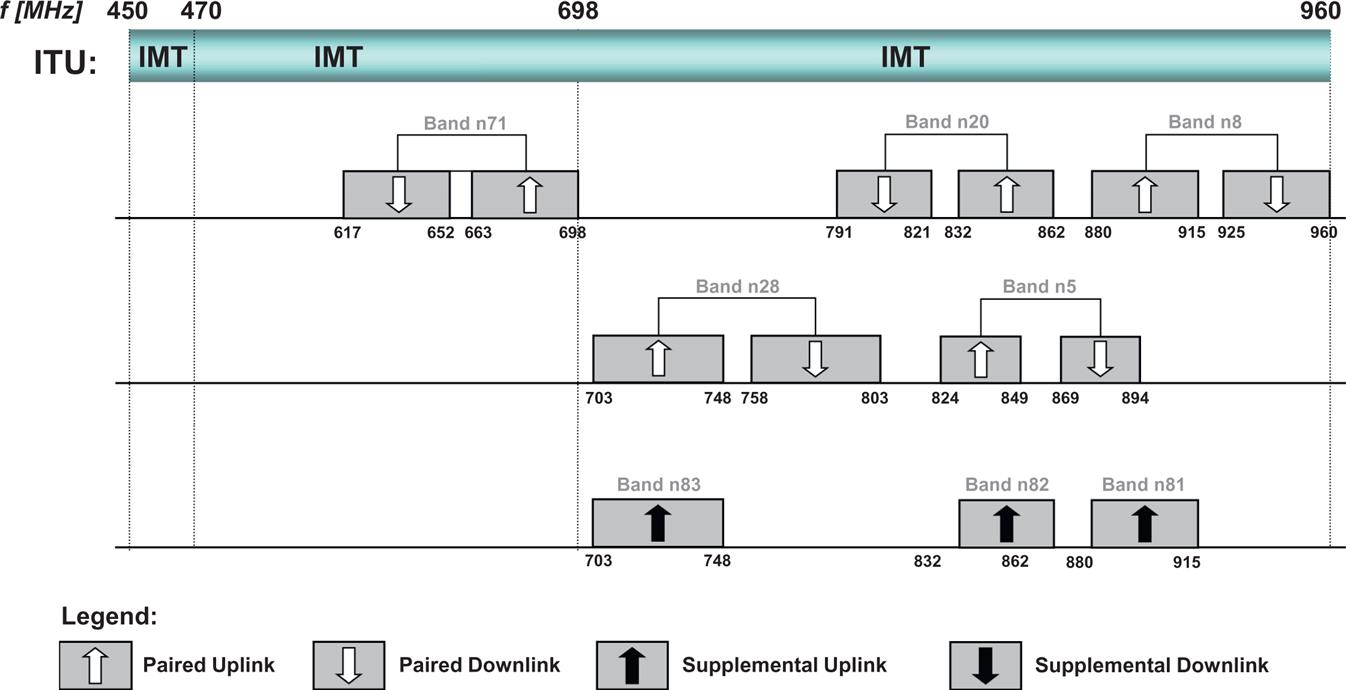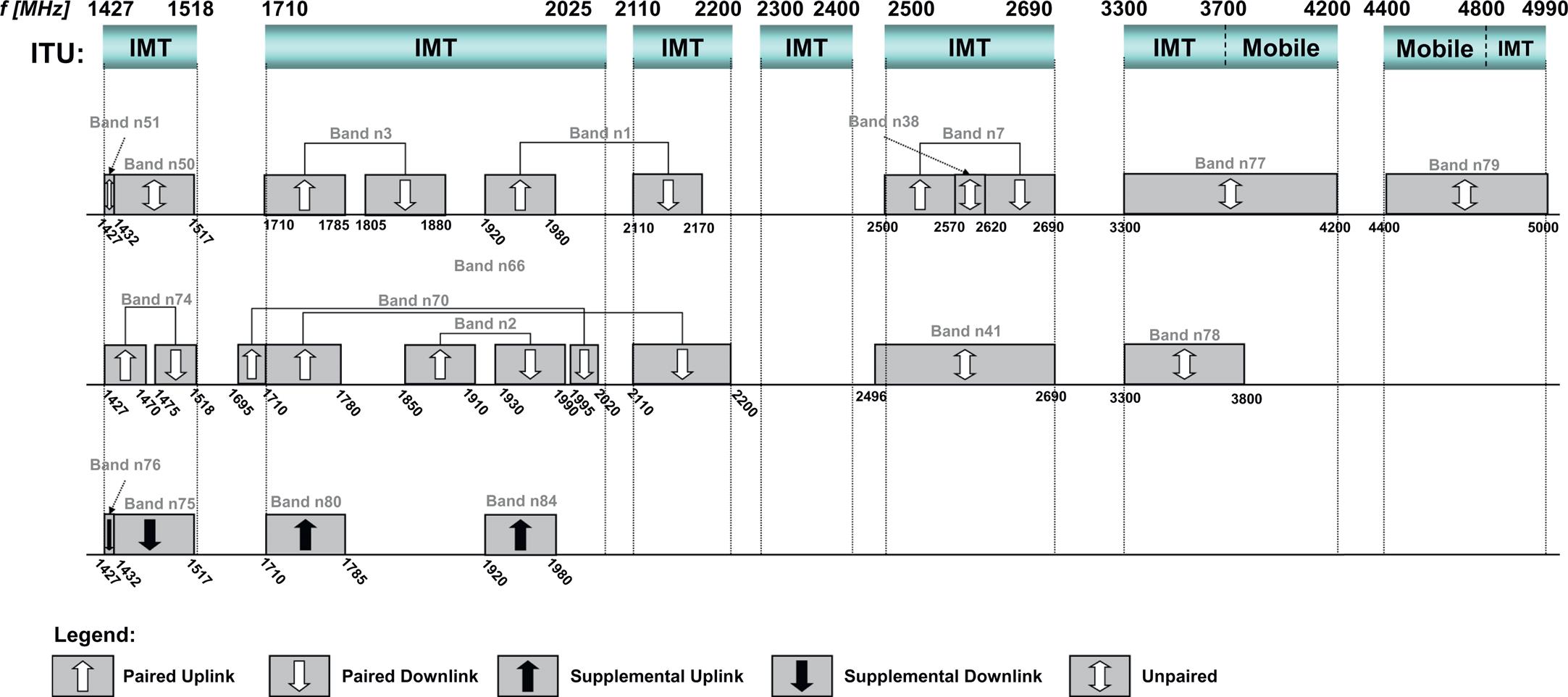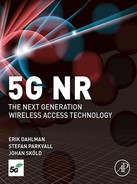Spectrum for 5G
Abstract
This chapter describes the internation al process for regulating spectrum and how the present IMT spectrum has been assinged by the ITU-R. Based on the outcome of the most recent WRC, the candidate 5G spectrum is presented together with all the operating bands specified for NR in 3GPP.
Keywords
Spectrum; WRC; IMT; allocation; frequency band; operating band; RF exposure
3.1 Spectrum for Mobile Systems
Historically, the bands for the first and second generation of mobile services were assigned at frequencies around 800–900 MHz, but also in a few lower and higher bands. When 3G (IMT-2000) was rolled out, focus was on the 2 GHz band and with the continued expansion of IMT services with 3G and 4G, new bands were added at both lower and higher frequencies, presently spanning from 450 MHz to around 6 GHz. While new, previously unexploited, frequency bands are continuously defined for new mobile generations, the bands used for previous generations are used for the new generation as well. This was the case when 3G and 4G were introduced and it will also be the case for 5G.
Bands at different frequencies have different characteristics. Due to the propagation properties, bands at lower frequencies are good for wide-area coverage deployments, in urban, suburban, and rural environments. Propagation properties of higher frequencies make them more difficult to use for wide-area coverage and, for this reason, higher-frequency bands have to a larger extent been used for boosting capacity in dense deployments.
With the introduction of 5G, the demanding eMBB usage scenario and related new services will require even higher data rates and high capacity in dense deployments. While many early 5G deployments will be in bands already used for previous mobile generations, frequency bands above 24 GHz are being looked at as a complement to the frequency bands below 6 GHz. With the 5G requirements for extreme data rates and localized areas with very high area traffic capacity demands, deployment using even higher frequencies, even above 60 GHz, are considered. Referring to the wavelength, these bands are often called mm-wave bands.
New bands are defined continuously by 3GPP, mainly for the LTE specification, but now also for the new NR specifications. Many new bands are defined for NR operation only. Both paired bands, where separated frequency ranges are assigned for uplink and downlink, and unpaired bands with a single shared frequency range for uplink and downlink, are included in the NR specifications. Paired bands are used for Frequency Division Duplex (FDD) operation, while unpaired bands are used for Time Division Duplex (TDD) operation. The duplex modes of NR are described further in Chapter 7. Note that some unpaired bands are defined as Supplementary Downlink (SDL) or Supplementary Uplink (SDL) bands. These bands are paired with the uplink or downlink of other bands through carrier aggregation, as described in Section 7.6.
3.1.1 Spectrum Defined for IMT Systems by the ITU-R
The ITU-R identifies frequency bands to use for mobile service and specifically for IMT. Many of these were originally identified for IMT-2000 (3G) and new ones came with the introduction of IMT-Advanced (4G). The identification is however technology and generation “neutral,” since the identification is for IMT in general, regardless of generation or Radio Interface Technology. The global designations of spectrum for different services and applications are done within the ITU-R and are documented in the ITU Radio Regulations [48] and the use of IMT bands globally is described in ITU-R Recommendation M.1036 [46].
The frequency listings in the ITU Radio Regulations [48] do not directly list a band for IMT, but rather allocate a band for the mobile service with a footnote stating that the band is identified for use by administrations wishing to implement IMT. The identification is mostly by region, but is in some cases also specified on a per-country level. All footnotes mention “IMT” only, so there is no specific mentioning of the different generations of IMT. Once a band is assigned, it is therefore up to the regional and local administrations to define a band for IMT use in general or for specific generations. In many cases, regional and local assignments are “technology neutral” and allow for any kind of IMT technology. This means that all existing IMT bands are potential bands for IMT-2020 (5G) deployment in the same way as they have been used for previous IMT generations.
The World Administrative Radio Congress WARC-92 identified the bands 1885–2025 and 2110–2200 MHz as intended for implementation of IMT-2000. Out of these 230 MHz of 3G spectrum, 2× 30 MHz were intended for the satellite component of IMT-2000 and the rest for the terrestrial component. Parts of the bands were used during the 1990s for deployment of 2G cellular systems, especially in the Americas. The first deployments of 3G in 2001–2 by Japan and Europe were done in this band allocation, and for that reason it is often referred to as the IMT-2000 “core band.”
Additional spectrum for IMT-2000 was identified at the World Radio-communication Conference1 WRC-2000, where it was considered that an additional need for 160 MHz of spectrum for IMT-2000 was forecasted by the ITU-R. The identification includes the bands used for 2G mobile systems at 806–960 and 1710–1885 MHz, and “new” 3G spectrum in the bands at 2500–2690 MHz. The identification of bands previously assigned for 2G was also a recognition of the evolution of existing 2G mobile systems into 3G. Additional spectrum was identified at WRC’07 for IMT, encompassing both IMT-2000 and IMT-Advanced. The bands added were 450–470, 698–806, 2300–2400, and 3400–3600 MHz, but the applicability of the bands varies on a regional and national basis. At WRC’12 there were no additional spectrum allocations identified for IMT, but the issue was put on the agenda for WRC’15. It was also determined to study the use of the band 694–790 MHz for mobile services in Region 1 (Europe, Middle East, and Africa).
WRC’15 was an important milestone setting the stage for 5G. First a new set of bands were identified for IMT, where many were identified for IMT on a global, or close to global, basis:
- • 470–694/698 MHz (600 MHz band): Identified for some countries in Americas and the Asia-Pacific. For Region 1, it is considered for a new agenda item for IMT at WRC-23.
- • 694–790 MHz (700 MHz band): This band is now also identified fully for Region 1 and is thereby a global IMT band.
- • 1427–1518 MHz (L-band): A new global band identified in all countries.
- • 3300–3400 MHz: Global band identified in many countries, but not in Europe or North America.
- • 3400–3600 MHz (C-band): Now a global band identified for all countries. The band was already allocated in Europe.
- • 3600–3700 MHz (C-band): Global band identified in many countries, but not in Africa and some counties in Asia-Pacific. In Europe, the band has been available since WRC’07.
- • 4800–4990 MHz: New band identified for a few countries in Asia-Pacific.
Especially the frequency range from 3300 to 4990 MHz is of interest for 5G, since it is new spectrum in higher frequency bands. This implies that it fits well with the new usage scenarios requiring high data rates and is also suitable for massive MIMO implementation, where arrays with many elements can be implemented with reasonable size. Since it is new spectrum with no widespread use for mobile systems today, it will be easier to assign this spectrum in larger spectrum blocks, thereby enabling wider RF carriers and ultimately higher end-user data rates.
The second major outcome from WRC’15 concerning IMT was the new agenda item (1.13) appointed for the next WRC, to identify high-frequency bands above 24 GHz for 5G mobile services. These bands will be studied by ITU-R until 2019 and be considered for IMT identification at WRC’19. The primary target for the bands is deployment of IMT-2020. A majority of the bands to be studied are already today assigned to the mobile service on a primary basis, in most bands together with fixed and satellite services. They consist of the following band ranges:
There are also bands to be studied for IMT that are presently not allocated to the mobile service on a primary basis and where it will be investigated whether the allocation can be changed to include mobile:
The complete set of bands is illustrated in Fig. 3.1.
ITU-R has formed a special task group TG 5/1, which will conduct sharing and compatibility studies for the new bands and prepare input for WRC’19 agenda item 1.13. The task group will document spectrum needs, technical and operational characteristics including protection criteria for existing services allocated in or adjacent to the bands studied, based on the studies. As an input to the studies, technical and operational characteristics of IMT-2020 were needed. These characteristics were provided from 3GPP as characteristics of NR, given at an early stage of standardization in January 2017.
It should be noted that there are also a large number of other frequency bands identified for mobile services, but not specifically for IMT. These bands are often used also for IMT on a regional or national basis. At WRC’15, there was some interest to also study 27.5–29.5 GHz for IMT, but it was not included in studies of 5G/IMT-2020 bands. Still, the band is planned for 5G mobiles services in at least the US and Korea. There was also support for studies of 5G/IMT-2020 in the frequency bands below 20 GHz, but those bands were ultimately not included. It is expected that several bands in the range 6–20 GHz will be considered for mobile services including IMT, in addition to the bands studied within ITU-R. One example is an FCC inquiry into new use, including next-generation wireless broadband services, in the frequency range 5925–7125 MHz.
The somewhat diverging arrangement between regions of the frequency bands assigned to IMT means that there is not one single band that can be used for roaming worldwide. Large efforts have, however, been put into defining a minimum set of bands that can be used to provide truly global roaming. In this way, multiband devices can provide efficient worldwide roaming for devices. With many of the new bands identified at WRC’15 being global or close to global, global roaming is made possible for devices using fewer bands and it also facilitates economy of scale for equipment and deployment.
3.1.2 Global Spectrum Situation for 5G
There is a considerable interest globally to make spectrum available for 5G deployments. This is driven by operators and industry organizations such as the Global mobile Suppliers Association [35] and DIGITALEUROPE [29], but is also supported by regulatory bodies in different countries and regions. An overview of the spectrum situation for 5G is given in [56]. In standardization, 3GPP has focused its activities on bands where a high interest is evident (the full list of bands is in Section 3.2). The spectrum of interest can be divided into bands at low, medium, and high frequencies:
Low-frequency bands correspond to existing LTE bands below 2 GHz, which are suitable as a coverage layer, providing wide and deep coverage, including indoor. The bands with highest interest here are the 600 and 700 MHz bands, which correspond to 3GPP NR bands n71 and n28 (see Section 3.2 for further details). Since the bands are not very wide, a maximum of 20 MHz channel bandwidth is expected in the low-frequency bands.
For early deployment, the 600 MHz band is considered for NR in the US, while the 700 MHz band is defined as one of the so-called pioneer bands for Europe. In addition, a number of additional LTE bands in the below 3 GHz range are identified for possible “re-farming” and have been assigned NR band numbers. Since the bands are in general already deployed with LTE, NR is expected to be deployed gradually at a later stage.
Medium-frequency bands are in the range 3–6 GHz and can provide coverage, capacity, as well as high data rates through the wider channel bandwidth possible. The highest interest globally is in the range 3300–4200 MHz, where 3GPP has designated NR bands n77 and n78. Due to the wider bands, channel bandwidths up to 100 MHz are possible. Up to 200 MHz per operator may be assigned in this frequency range in the longer term, where carrier aggregation could then be used to deploy the full bandwidth.
The range 3300–4200 MHz is of global interest, with some variations seen regionally; and 3400–3800 MHz is a pioneer band in Europe, while China and India are planning for 3300–600 MHz and in Japan 3600–4200 MHz is being considered. Similar frequency ranges are considered in North America (3550–3700 MHz and initial discussions about 3700–4200 MHz), Latin America, the Middle East, Africa, India, Australia, etc. A total of 45 countries signed up to the IMT identification of the 3300–3400 MHz band in WRC-15. There is also a large amount of interest for a higher band in China (primarily 4800–5000 MHz) and Japan (4400–4900 MHz). In addition, there are a number of potential LTE re-farming bands in the 2–6 GHz range that have been identified as NR bands.
High-frequency bands are in the mm-Wave range above 24 GHz. They will be best suited for hotspot coverage with locally very high capacity and can provide very high data rates. The highest interest is in the range 24.25–29.5 GHz, with 3GPP NR bands n257 and n258 assigned. Channel bandwidths up to 400 MHz are defined for these bands, with even higher bandwidths possible through carrier aggregation.
The mmWave frequency range is new for IMT deployment, as discussed above. The band 27.5–28.35 was identified at an early stage in the US, while 24.25–27.5 GHz, also called the “26 GHz band,” is a pioneer band for Europe, noting that not all of it may be made available for 5G. Different parts of the larger range 24.25–29.5 GHz are being considered globally. The range 27.5–29.5 GHz is the first range planned for Japan and 26.5–29.5 GHz in Korea. Overall, this band can be seen as global with regional variations. The range 37–40 GHz is also planned for the US and similar ranges around 40 GHz are considered in many other regions too, including China.
3.2 Frequency Bands for NR
NR can be deployed both in existing IMT bands and in future bands that may be identified at WRC, or in regional bodies. The possibility of operating a radio-access technology in different frequency bands is a fundamental aspect of global mobile services. Most 2G, 3G, and 4G devices are multiband capable, covering bands used in the different regions of the world to provide global roaming. From a radio-access functionality perspective, this has limited impact and the physical-layer specifications such as those for NR do not assume any specific frequency band. Since NR however spans such a vast range of frequencies, there are certain provisions that are intended only for certain frequency ranges. This includes how the different NR numerologies can be applied (see Chapter 7).
Many RF requirements are specified with different requirements across bands. This is certainly the case for NR, but also for previous generations. Examples of band-specific RF requirements are the allowed maximum transmit power, requirements/limits on out-of-band (OOB) emission and receiver blocking levels. Reasons for such differences are varying external constraints, often imposed by regulatory bodies, in other cases differences in the operational environment that are considered during standardization.
The differences between bands are more pronounced for NR due to the very wide range of frequency bands. For NR operation in the new mm-Wave bands above 24 GHz, both devices and base stations will be implemented with partly novel technology and there will be a more widespread use of massive MIMO, beam forming, and highly integrated advanced antenna systems. This creates differences in how RF requirements are defined, how they are measured for performance assessment and ultimately also what the limits for the requirements are set. Frequency bands within the scope of the present Release 15 work in 3GPP are for this reason divided into two frequency ranges:
These frequency ranges may be extended or complemented with new ranges in future 3GPP releases. The impact of the frequency ranges on the RF requirements is further discussed in Chapter 18.
The frequency bands where NR will operate are in both paired and unpaired spectra, requiring flexibility in the duplex arrangement. For this reason, NR supports both FDD and TDD operation. Some ranges are also defined for SDL or SUL. These features are further described in Section 7.7.
3GPP defines operating bands, where each operating band is a frequency range for uplink and/or downlink that is specified with a certain set of RF requirements. The operating bands each have a number, where NR bands are numbered n1, n2, n3, etc. When the same frequency range is defined as an operating band for different radio access technologies, the same number is used, but written in a different way. 4G LTE bands are written with Arabic numerals (1, 2, 3, etc.), while 3G UTRA bands are written with Roman numerals (I, II, II, etc.). LTE operating bands that are used with the same arrangement for NR are often referred to as “LTE re-farming bands.”
Release 15 of the 3GPP specifications for NR includes 26 operating bands in frequency range 1 and three in frequency range 2. Bands for NR have a numbering scheme with assigned numbers from n1 to n512 using the following rules:
The scheme “conserves” band numbers and is backwards compatible with LTE (and UTRA) and does not lead to any new LTE numbers above 256, which is the present maximum possible. Any new LTE-only bands can also be assigned unused numbers below 65. In release 15, the operating bands in frequency range 1 are in the range n1 to n84 as shown in Table 3.1. The bands in frequency range 2 are in the range from n257 to n260, as shown in Table 3.2. All bands for NR are summarized in Figs. 3.2, 3.3, and 3.4, which also show the corresponding frequency allocation defined by the ITU-R.
Table 3.1

Table 3.2




Some of the frequency bands are partly or fully overlapping. In most cases this is explained by regional differences in how the bands defined by the ITU-R are implemented. At the same time, a high degree of commonality between the bands is desired to enable global roaming. Originating in global, regional, and local spectrum developments, a first set of bands was specified as bands for UTRA. The complete set of UTRA bands later transferred to the LTE specifications in 3GPP Release 8. Additional bands have been added in later releases. In release 15, many of the LTE bands are now transferred to the NR specifications.
3.3 RF Exposure Above 6 GHz
With the expansion of the frequency ranges for 5G mobile communications to bands above 6 GHz, existing regulations on human exposure to RF electromagnetic fields (EMFs) may restrict the maximum output power of user devices to levels significantly lower than what are allowed for lower frequencies.
International RF EMF exposure limits, for example those recommended by the International Commission on Non-Ionizing Radiation (ICNIRP) and those specified by the Federal Communications Commission (FCC) in the US, have been set with wide safety margins to protect against excessive heating of tissue due to energy absorption. In the frequency range of 6–10 GHz, the basic limits change from being specified as specific absorption rate (W/kg) to incident power density (W/m2). This is mainly because the energy absorption in tissue becomes increasingly superficial with increasing frequency, and thereby more difficult to measure.
It has been shown that for products intended to be used in close proximity to the body, there will be a discontinuity in maximum allowed output power as the transition is made from specific absorption rate to power density-based limits [27]. To be compliant with ICNIRP exposure limits at the higher frequencies, the transmit power might have to be up to 10 dB below the power levels used for current cellular technologies. The exposure limits above 6 GHz appear to have been set with safety margins even larger than those used at lower frequencies, and without any obvious scientific justification.
For the lower-frequency bands, large efforts have been spent over the years to characterize the exposure and to set relevant limits. With a growing interest for utilizing frequency bands above 6 GHz for mobile communications, research efforts are likely to increase which eventually may lead to revised exposure limits. In the most recent RF exposure standards published by IEEE (C95.1-2005, C95.1-2010a), the inconsistency at the transition frequency is less evident. However, these limits have not yet been adopted in any national regulation and it is important also that other standardization organizations and regulators work to address this issue. If not, this might have a large negative impact on coverage at higher frequencies, in particular for user equipment intended to be used near the body, such as wearables, tablets, and mobile phones, for which the maximum transmit power might be heavily limited by the current RF exposure regulations.

